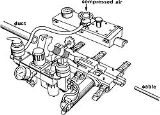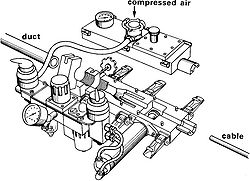
Cable jetting
Encyclopedia
Cable jetting is a technique to install cables in ductshttp://www.plumettaz.ch/en/products/optical_fiber/jetting_explanation.asp. It is commonly used to install cables with optical fiber
s in underground polyethylene
ducts and is an alternative to pulling.
is multiplied by a friction
dependent factor (which can be reduced by using lubricant
http://www.polywater.com/lubricants.asp). This means that the higher the local pulling force is, the higher the friction will be which the cable is experiencing while being pulled against the internal duct wall. This "capstan effect
"http://pergatory.mit.edu/2.007/lectures/final/Topic_05_Power_Transmission_Components.pdf leads to an exponential force build-up with pull distance, producing generally high pulling forces.
 Cable jetting is the process of blowing a cable through a duct while simultaneously pushing the cable into the duct. Compressed air
Cable jetting is the process of blowing a cable through a duct while simultaneously pushing the cable into the duct. Compressed air
is injected at the duct inlet and flows through the duct and along the cable at high speed. (Preferably, no suction
pig is used at the cable head.) The high speed air propels the cable due to drag forces and pressure
drop. The friction of the cable against the duct is reduced by the distributed airflow, and large forces that would generate high friction are avoided. Because of the expanding airflow, the air propelling forces are relatively small at the cable inlet and large at the air exhaust end of the duct. To compensate for this, an additional pushing force is applied to the cable by the jetting equipment. The pushing force, acting mainly near the cable inlet, adds synergistically with the airflow propelling forces, increasing the maximum jetting distance considerably. Special lubricants have been developed for cable jetting to further reduce friction http://www.polywater.com/blowing.asp.
(3 mm internal diameter) http://communications.draka.com/sites/eu/Pages/Microduct-Outside-Plant-Solutions-Connecting-with-JetNetXS.aspx http://www.rala.se/products.asp up to large copper telecom cables (35 mm diameter) in large ducts (50 mm internal diameter). Jetting is done with a pressure of the compressed air in the order of 10 bar
. With the jetting technique distances per blow of 3.5 km have been reached http://fibers.org/articles/news/7/9/2, while spliceless links of 12 km have been reached by placing jetting equipment in tandem. It is possible to install 12 km in one day with one small crew.
In mid 1990s the technique was also developed to install multiple smaller microducts
, bundles, into a larger duct in one installation. This is called multi-ducting, microduct cabling, or bundle blowing. Each can hold a cable.
Another capability is to install a single cable or a bundle of small ducts into an occupied duct. The most cost driving activity of installing a network is the need for civil works. Thus, re-using ducts occupied with one cable, leaving some space, is a tempting and often possible and cost effective alternative.
in the late 1980s http://v3.espacenet.com/textdoc?DB=EPODOC&IDX=GR3003263T&F=0. The necessary equipment was developed in cooperation with Plumettaz, Switzerland.
Optical fiber
An optical fiber is a flexible, transparent fiber made of a pure glass not much wider than a human hair. It functions as a waveguide, or "light pipe", to transmit light between the two ends of the fiber. The field of applied science and engineering concerned with the design and application of...
s in underground polyethylene
Polyethylene
Polyethylene or polythene is the most widely used plastic, with an annual production of approximately 80 million metric tons...
ducts and is an alternative to pulling.
Pulling
Traditionally fibre optic cables were pulled through cable ducts in the same way as other cables, via a winch line. Every time a bend or undulation in the duct is passed the pulling forceForce
In physics, a force is any influence that causes an object to undergo a change in speed, a change in direction, or a change in shape. In other words, a force is that which can cause an object with mass to change its velocity , i.e., to accelerate, or which can cause a flexible object to deform...
is multiplied by a friction
Friction
Friction is the force resisting the relative motion of solid surfaces, fluid layers, and/or material elements sliding against each other. There are several types of friction:...
dependent factor (which can be reduced by using lubricant
Lubricant
A lubricant is a substance introduced to reduce friction between moving surfaces. It may also have the function of transporting foreign particles and of distributing heat...
http://www.polywater.com/lubricants.asp). This means that the higher the local pulling force is, the higher the friction will be which the cable is experiencing while being pulled against the internal duct wall. This "capstan effect
Capstan
Capstan may refer to:*Capstan , a rotating machine used to control or apply force to another element*Capstan , rotating spindles used to move recording tape through the mechanism of a tape recorder...
"http://pergatory.mit.edu/2.007/lectures/final/Topic_05_Power_Transmission_Components.pdf leads to an exponential force build-up with pull distance, producing generally high pulling forces.
Jetting

Pneumatics
Pneumatics is a branch of technology, which deals with the study and application of use of pressurized gas to effect mechanical motion.Pneumatic systems are extensively used in industry, where factories are commonly plumbed with compressed air or compressed inert gases...
is injected at the duct inlet and flows through the duct and along the cable at high speed. (Preferably, no suction
Suction
Suction is the flow of a fluid into a partial vacuum, or region of low pressure. The pressure gradient between this region and the ambient pressure will propel matter toward the low pressure area. Suction is popularly thought of as an attractive effect, which is incorrect since vacuums do not...
pig is used at the cable head.) The high speed air propels the cable due to drag forces and pressure
Pressure
Pressure is the force per unit area applied in a direction perpendicular to the surface of an object. Gauge pressure is the pressure relative to the local atmospheric or ambient pressure.- Definition :...
drop. The friction of the cable against the duct is reduced by the distributed airflow, and large forces that would generate high friction are avoided. Because of the expanding airflow, the air propelling forces are relatively small at the cable inlet and large at the air exhaust end of the duct. To compensate for this, an additional pushing force is applied to the cable by the jetting equipment. The pushing force, acting mainly near the cable inlet, adds synergistically with the airflow propelling forces, increasing the maximum jetting distance considerably. Special lubricants have been developed for cable jetting to further reduce friction http://www.polywater.com/blowing.asp.
Advantages of jetting compared to pulling
- Longer installation distances can be reached
- Installation distance less dependent on bends and undulations in duct
- Forces exerted on the cable are lower
- Easier use jet in tandem operation
- The step of installing a winch rope is avoided
- Equipment is needed only at one end of the duct route
Practice
In the 21st century the cable jetting technique is used worldwide, from small optical telecom cables (1.8 mm diameter) in small microductsMicroducts
Microducts are small ducts for the installation of small microduct fibre optic cables. They have a size ranging from typically 3 to 16 mm and are installed as bundles in larger ducts.-Traditional duct installation:...
(3 mm internal diameter) http://communications.draka.com/sites/eu/Pages/Microduct-Outside-Plant-Solutions-Connecting-with-JetNetXS.aspx http://www.rala.se/products.asp up to large copper telecom cables (35 mm diameter) in large ducts (50 mm internal diameter). Jetting is done with a pressure of the compressed air in the order of 10 bar
Bar (unit)
The bar is a unit of pressure equal to 100 kilopascals, and roughly equal to the atmospheric pressure on Earth at sea level. Other units derived from the bar are the megabar , kilobar , decibar , centibar , and millibar...
. With the jetting technique distances per blow of 3.5 km have been reached http://fibers.org/articles/news/7/9/2, while spliceless links of 12 km have been reached by placing jetting equipment in tandem. It is possible to install 12 km in one day with one small crew.
In mid 1990s the technique was also developed to install multiple smaller microducts
Microducts
Microducts are small ducts for the installation of small microduct fibre optic cables. They have a size ranging from typically 3 to 16 mm and are installed as bundles in larger ducts.-Traditional duct installation:...
, bundles, into a larger duct in one installation. This is called multi-ducting, microduct cabling, or bundle blowing. Each can hold a cable.
Another capability is to install a single cable or a bundle of small ducts into an occupied duct. The most cost driving activity of installing a network is the need for civil works. Thus, re-using ducts occupied with one cable, leaving some space, is a tempting and often possible and cost effective alternative.
History
The technique of installing flexible and lightweight fibre optic units using compressed air was developed during the 1980s by British Telecom http://v3.espacenet.com/textdoc?DB=EPODOC&IDX=EP0186753&F=0&QPN=EP0186753. This early version of jetting did not use additional pushing. True cable jetting was invented by Willem Griffioen of KPN ResearchKPN
KPN is a Dutch landline and mobile telecommunications company, including both 2G and 3G mobile operations...
in the late 1980s http://v3.espacenet.com/textdoc?DB=EPODOC&IDX=GR3003263T&F=0. The necessary equipment was developed in cooperation with Plumettaz, Switzerland.

